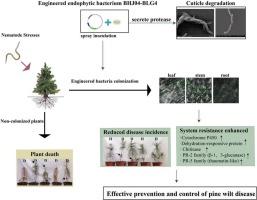工程细菌abietaniphila Pseudomonas BHJ04-BLG4通过杀线虫活性和诱导宿主系统抗性来控制松树枯萎病
IF 4
1区 农林科学
Q2 BIOCHEMISTRY & MOLECULAR BIOLOGY
引用次数: 0
摘要
松材萎蔫病(PWD)是由松材萎蔫菌(Bursaphelenchus xylophilus)引起的全球性森林病害,微生物防治具有广阔的应用前景。马尾松内生细菌假单胞菌(Pseudomonas abietaniphila BHJ04)可诱导宿主产生抗性。为了提高其对PWD的生物防治效果,我们对该菌株进行了改造,在保持抗性诱导的同时提高了杀线虫活性。将一种编码细胞外碱性丝氨酸蛋白酶BLG4的外源杀线虫基因通过偶联转移导入BHJ04,得到菌株BHJ04-BLG4。马尾松茎中的定殖在接种后15 d达到峰值(2.06 × 104拷贝/μL)。体外实验表明,纯化后的BLG4可降解线虫表皮并杀死线虫(IC50 = 35.98 μg/mL),而培养48 h后的粗裂解液上清可达到100%的杀线虫活性。在温室试验中,BHJ04-BLG4将PWD发病率降低至40%(防治效果为86.66%)。RT-qPCR结果显示,宿主防御基因:脱水反应蛋白(48 h 315.06倍)和几丁质酶、PR-2 (β-1,3-葡聚糖酶)和PR-5(梭马汀样蛋白)基因(24-48 h 7.43 - 34.26倍)显著诱导。初步生态安全试验表明,BHJ04-BLG4对烟草、紫花苜蓿和雷氏弓形虫无致病症状。这些发现表明BHJ04-BLG4通过直接杀线虫活性和宿主系统抗性诱导的协同机制增强了对PWD的抗性。这种工程菌株代表了一种新的可持续的生物防治策略。本文章由计算机程序翻译,如有差异,请以英文原文为准。

Engineered bacterium Pseudomonas abietaniphila BHJ04-BLG4 controls pine wilt disease via nematocidal activity and induction of host systemic resistance
Pine wilt disease (PWD), caused by Bursaphelenchus xylophilus, is a destructive global forest disease for which microbial control offers promising potential. Pseudomonas abietaniphila BHJ04, an endophytic bacterium from Pinus massoniana, has been shown to induce host resistance. To enhance its biocontrol efficacy against PWD, we engineered this strain to improve nematicidal activity while maintaining resistance induction. An exogenous nematicidal gene encoding the extracellular alkaline serine protease BLG4 was introduced into BHJ04 by conjugation transfer, generating strain BHJ04-BLG4. Colonization in P. massoniana stems peaked 15 days post-inoculation (2.06 × 104 copies/μL). In vitro assays demonstrated that purified BLG4 degraded nematode cuticles and killed nematodes (IC50 = 35.98 μg/mL), while crude lysate supernatant from 48 h cultures achieved 100 % nematicidal activity. In greenhouse trials, BHJ04-BLG4 reduced PWD incidence to 40 % (control efficacy: 86.66 %). RT-qPCR showed significant induction of host defense genes: dehydration-responsive protein (315.06-fold at 48 h), and chitinase, PR-2 (β-1,3-glucanase), and PR-5 (thaumatin-like protein) genes (7.43–34.26-fold within 24–48 h). Preliminary ecological safety tests indicated that BHJ04-BLG4 caused no disease symptoms in tobacco, alfalfa, or P. thunbergii. These findings suggest that BHJ04-BLG4 confers enhanced resistance to PWD through synergistic mechanisms of direct nematicidal activity and host systemic resistance induction. This engineered strain represents a novel and sustainable biocontrol strategy for PWD management.
求助全文
通过发布文献求助,成功后即可免费获取论文全文。
去求助
来源期刊
CiteScore
7.00
自引率
8.50%
发文量
238
审稿时长
4.2 months
期刊介绍:
Pesticide Biochemistry and Physiology publishes original scientific articles pertaining to the mode of action of plant protection agents such as insecticides, fungicides, herbicides, and similar compounds, including nonlethal pest control agents, biosynthesis of pheromones, hormones, and plant resistance agents. Manuscripts may include a biochemical, physiological, or molecular study for an understanding of comparative toxicology or selective toxicity of both target and nontarget organisms. Particular interest will be given to studies on the molecular biology of pest control, toxicology, and pesticide resistance.
Research Areas Emphasized Include the Biochemistry and Physiology of:
• Comparative toxicity
• Mode of action
• Pathophysiology
• Plant growth regulators
• Resistance
• Other effects of pesticides on both parasites and hosts.

 求助内容:
求助内容: 应助结果提醒方式:
应助结果提醒方式:


